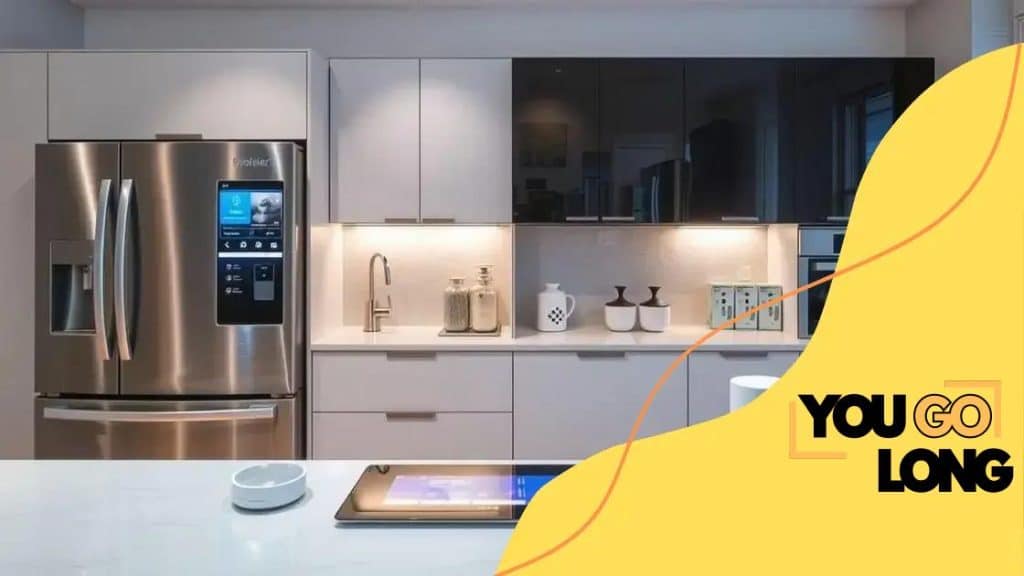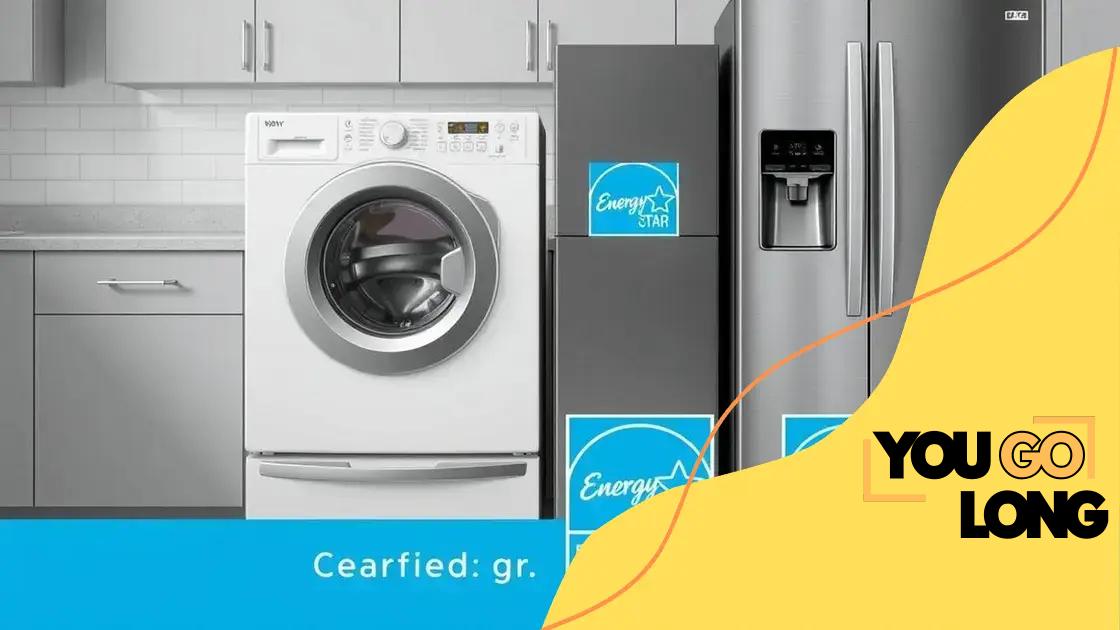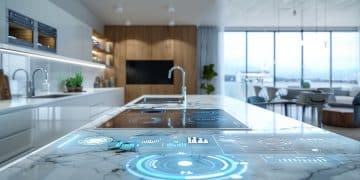Future trends in home appliances for smarter living

Advertisement
The future of kitchen gadgets includes innovations like smart integration, personalized cooking experiences, and energy-efficient technologies that streamline meal preparation and enhance convenience in modern homes.
Future trends in home appliances for smarter living are reshaping how we interact with technology at home. Have you ever imagined a kitchen where your fridge suggests recipes or your oven cooks your meals on command? Keep reading as we delve into these fascinating trends that promise to make our lives simpler and more efficient.
Smart refrigerators and their features
Smart refrigerators represent a significant leap in kitchen technology. These appliances do much more than just keep your food cold. They offer a range of features designed to make life easier and more efficient.
One impressive feature is the built-in touchscreen. This allows you to check recipes, create shopping lists, and even see inside your fridge without opening the door. Smart refrigerators can help manage food inventory, remind you of expiration dates, and even suggest meals based on what you have.
Advertisement
Features of Smart Refrigerators
Many smart refrigerators come with multiple features that enhance convenience:
- Internet connectivity for remote management
- Voice control integration with assistants like Alexa or Google Assistant
- Customizable temperature zones for different types of food
These elements not only improve functionality but also reduce food waste and save money. Imagine a fridge that tells you when you’re running low on milk or when your produce is about to expire.
Energy Efficiency
Smart refrigerators are also designed with energy efficiency in mind. Many models have energy-saving modes that help lower electricity costs. This is an important feature considering the rising concern for sustainability.
Advertisement
Moreover, some units can monitor your energy usage, allowing you to make adjustments that reduce your carbon footprint. It’s a perfect blend of smart technology and responsible living.
The integration of cameras inside your refrigerator adds another layer of convenience. You can check what’s inside without opening the door, making grocery shopping more efficient and less wasteful.
In summary, smart refrigerators bring innovation into the home, making food storage smarter and cooking more enjoyable. With a plethora of features designed to enhance convenience and efficiency, investing in one might be a great choice for a modern kitchen.
Voice-activated appliances for convenience
Voice-activated appliances are revolutionizing how we interact with technology in our homes. These devices allow users to control functions simply by speaking, adding a layer of convenience and efficiency to daily tasks.
Imagine preparing dinner while your hands are busy, yet you can turn on the oven or adjust the lights just by speaking. This level of convenience makes cooking and other household chores much easier. These appliances respond to commands from virtual assistants like Amazon Alexa or Google Assistant, allowing for seamless integration into your smart home system.
Benefits of Voice-Activated Appliances
There are several benefits to using voice-activated appliances:
- Hands-free operation, great for multitasking
- Accessibility for individuals with mobility issues
- Quick access to information and control without physical interaction
This technology is not just about luxury; it enhances accessibility too. For individuals with disabilities, being able to control devices with their voice can significantly improve their quality of life. Voice commands can perform various functions, from adjusting the thermostat to playing music, all while making daily routines more manageable.
Popular Voice-Activated Appliances
Some popular examples of voice-activated appliances include:
- Smart ovens that allow you to set temperatures and timers
- Voice-controlled coffee makers that brew your coffee on your command
- Smart home security systems that can be monitored and controlled with voice
These devices are not only innovative but also contribute to energy efficiency. You can turn off devices you may have forgotten about, ultimately saving on energy bills. The convenience of simply asking your appliance to perform tasks frees up your time for more important activities.
As technology advances, we can expect even more features and capabilities from voice-activated appliances. Future innovations might include advanced learning algorithms that understand your preferences, making your home even smarter.
Energy-efficient technologies in modern appliances

Energy-efficient technologies are transforming modern appliances, making them better for the environment and more cost-effective for consumers. These innovations not only help reduce energy consumption but also support sustainable living practices.
Many of today’s appliances come equipped with features designed to minimize energy use. For instance, smart thermostats can learn your schedule and adjust heating and cooling accordingly. This means your home stays comfortable while wasting less energy.
Key Features of Energy-Efficient Appliances
Here are some important features to look for in energy-efficient appliances:
- Energy Star certification ensures compliance with strict efficiency guidelines.
- Advanced insulation helps maintain temperature without excess energy usage.
- Variable-speed motors that adjust their speed based on needs, reducing energy when full power isn’t required.
These technologies work together to provide substantial savings on utility bills. For example, a modern dishwasher might use less water and energy than older models while providing improved cleaning performance.
Benefits of Energy Efficiency
Choosing energy-efficient technologies offers several benefits:
- Lower utility bills over time, contributing to significant savings.
- Reduced carbon footprint, promoting a healthier planet.
- Increased appliance lifespan due to less strain on the devices.
Understanding these benefits can lead to more informed choices when purchasing appliances. Many consumers are surprised to find that selecting energy-efficient options is not only good for the planet but also for their wallets.
Moreover, with the rise of smart technology, many energy-efficient appliances can be monitored and controlled via smartphone apps. This allows homeowners to track energy usage and make adjustments as needed, further enhancing efficiency.
Smart home integration and automation
Smart home integration and automation are transforming our living spaces into efficient, responsive environments. By connecting various devices, homeowners can control everything from lights to security systems with ease.
Imagine being able to turn off lights, adjust the thermostat, or even lock the front door all from your smartphone. This level of control enhances convenience and provides peace of mind, especially when you’re away from home.
Key Components of Smart Home Integration
Here are some key components of smart home integration:
- Smart hubs that connect various devices into one system
- Voice assistants like Amazon Alexa or Google Assistant for easy command execution
- Smart sensors that monitor activity, temperature, and more
These components work together, allowing for seamless communication between devices. For example, when you leave home, your smart system can automatically turn off lights and lower the thermostat to save energy.
Benefits of Home Automation
Automation brings several advantages to everyday living:
- Enhanced convenience and time-saving through remote access
- Improved energy efficiency by optimizing usage
- Increased security with real-time alerts and remote monitoring
With devices working together, you can set routines tailored to your lifestyle. For instance, your system can automatically turn on your coffee maker in the morning or lock doors at night, taking care of tedious tasks so you don’t have to worry.
Moreover, the ability to monitor your home through smart cameras or sensors provides additional security. You can receive alerts on your phone if there’s unusual activity, giving you control and awareness wherever you are.
The future of kitchen gadgets
The future of kitchen gadgets promises exciting advancements that will revolutionize how we cook and prepare meals. With ongoing technological developments, we can expect innovative tools that offer convenience, speed, and efficiency.
Imagine using a gadget that not only cooks your meal but also suggests recipes based on the ingredients you have on hand. These kitchen gadgets will harness artificial intelligence to transform food preparation into a more interactive and personalized experience.
Innovative Features to Expect
As technology progresses, here are some innovative features likely to emerge:
- Smart countertop appliances that can communicate with each other for coordinated cooking.
- Automated meal prep tools that chop, mix, and cook with minimal user input.
- Enhanced sustainability features, such as gadgets that minimize food waste or utilize solar energy.
These advancements will not only save time but also make cooking more enjoyable and less stressful. The integration of smart technology can help monitor nutritional content, ensuring meals are both delicious and healthy.
Personalized Cooking Experiences
Future kitchen gadgets will also focus on customization for individual tastes. Imagine a blender that adjusts its settings based on your preferred smoothie consistency or a coffee maker that brews your ideal cup based on past preferences.
This personalization will enhance user engagement, making cooking feel less like a chore and more like a creative outlet. Additionally, improvements in connectivity will allow gadgets to relay information to mobile apps, enabling remote control and monitoring from anywhere.
As we look ahead, the integration of user-friendly interfaces and intuitive designs will encourage more people to experiment in the kitchen. Expect to see gadgets that can be controlled through voice commands or mobile devices, making cooking accessible for everyone.
FAQ – Frequently Asked Questions about the Future of Kitchen Gadgets
What are smart kitchen gadgets?
Smart kitchen gadgets are appliances that utilize technology to enhance cooking and meal preparation, often connected to the internet for better control and automation.
How can technology improve my cooking experience?
Technology can integrate devices, automate tasks, and provide personalized recommendations, making cooking more efficient and enjoyable.
Are energy-efficient kitchen gadgets worth the investment?
Yes, energy-efficient gadgets save on utility bills over time and contribute to a more sustainable lifestyle.
What features should I look for in future kitchen gadgets?
Look for features like smart integration, automation capabilities, energy efficiency, and user-friendly interfaces.





